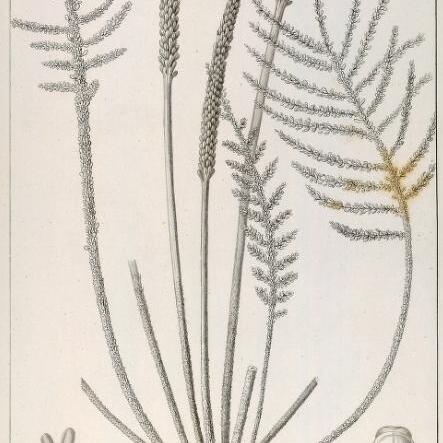Leaves submerged or emergent, basal, usually rosulate, often fern-like in appearance with a dorsal (abaxial) and ventral (adaxial) surface, 1–2-pinnate, 2–3-pinnatisect (entire or lobed), dilated and ligulate at the base; petiole and rhachis ± dorso-ventrally flattened and ± densely covered with wart-like or tongue-shaped outgrowths (emergences); pinnae (primary divisions of the leaf) numerous, subopposite, ± cylindrical in outline, bearing simple to variously divided emergences all around the pinna axis, sometimes also with secondary branches (pinnules)
Flowers unisexual, solitary in the axil of an enclosing bract, sessile; bracts spirally arranged, imbricate, differing in form between the sexes, distal part of bract variously margined or flanged, proximal part or spur [the éperon of Cusset] concave; sepals and petals absent
Inflorescences emergent, scapiform, densely spicate (resembling fruiting spikes of Plantago), produced as water level recedes; peduncle verrucose, rarely smooth or becoming so (on dried specimens at least) as emergences are shed
Female flower reduced to a 2-carpellate unilocular ovary; ovules numerous, anatropous; styles 2, filiform, exserted from bracts, persistent on the fruit
Aquatic herbs attached to rocks in waterfalls and fast-flowing fresh water, usually dioecious, rhizomatous or sometimes stoloniferous
Male flower reduced to a single subsessile stamen; anther thecae 2, dehiscing longitudinally
Fruit a small capsule enclosed by the persistent bract, 2-valved
Rhizomes discoid or tuberous; roots numerous, radiating
Seeds small, numerous
